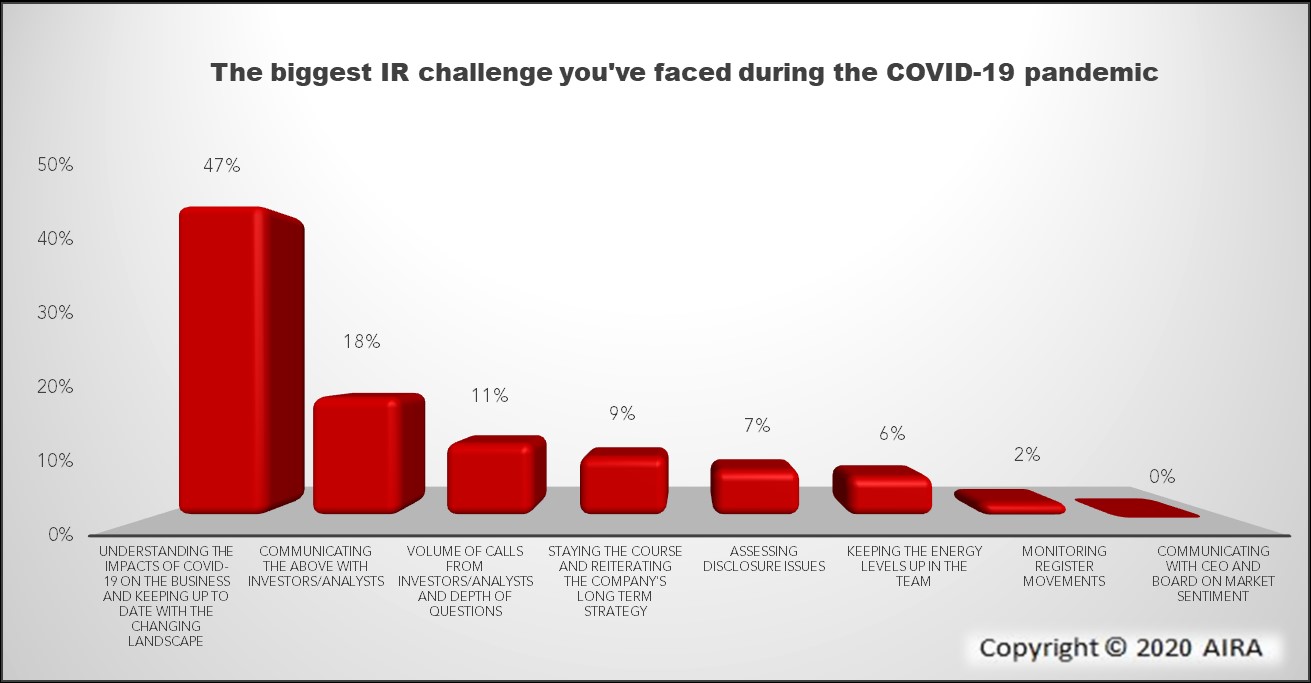The Covid-19 pandemic has forced everyone to get much better acquainted with videoconferencing technology. Amid worldwide lockdown restrictions, people have used video calls to stay in touch with friends, family and work colleagues.
The same is true for IR teams and their investor outreach. A recent survey by IHS Markit finds that, while less than half of IROs had conducted video investor meetings prior to the crisis, nine in 10 expect to do so in the next 12 months.
But which videoconferencing tool are IROs using? When making a decision, they must balance questions of security, cost, management comfort, technical support and ease of use. Complicating the picture, some financial firms have banned the use of certain products, deeming their level of security insufficient.
During a recent webinar held by the Australasian Investor Relations Association (AIRA), IROs offered a snapshot of the tools they are currently using. In a poll answered by webinar attendees, the preferred technology for one-on-one virtual meetings is Zoom (selected by 27 percent).
Second place goes to Microsoft Teams (23 percent), followed by Cisco’s Webex (20 percent). Notably, around one in five respondents (19 percent) say the tried-and-tested conference call remains their favored way to conduct virtual meetings with investors and analysts.

‘It will be interesting to see whether the surge in the use of technology for virtual IR purposes remains when things normalize. I suspect in-person meetings will return but probably not to the same extent,’ says Ian Matheson, CEO of AIRA.
‘The absence of in-person meetings with investors does not seem to have impacted investment decisions so far. It will be interesting to see whether investors demand in-person meetings with management again when they are possible.’
Zoom has become a highly popular but also controversial option for video calls during the Covid-19 pandemic. While use of the tool has skyrocketed, the media has reported incidents of so-called Zoom-bombing, where uninvited individuals enter meetings and post obscene content.
In response, Zoom has rolled out a series of security enhancements, including increasing the level of encryption on calls and adding new privacy tools. The firm also hired Alex Stamos, a former security chief at Facebook, as an adviser.
Speaking during an IR Magazine virtual event in April, Jason Oury, head of global advisory for issuer solutions at IHS Markit, said videoconference technology has been available to IROs and investors for a while, but they weren’t taking advantage of it.
‘CEOs want to meet in person with investors, they want to see the whites of eyes, they want to shake hands. And I think that’s all extremely impactful and effective,’ he said. ‘But software like Zoom and Microsoft Teams, for day-to-day meetings with investors, works pretty well. And there are solutions if you want to meet more en masse and mimic a non-deal roadshow for half a day or a full day.’
The pandemic has also boosted the use of high-touch videoconference services that work across different platforms. OpenExchange, one such firm, says it conducted more meetings in the first three months of 2020 then in the whole of the previous year.
Despite the popularity of Zoom during the Covid-19 outbreak, some larger companies and banks have banned or discouraged its use, citing security or compliance issues. Others continue to use Zoom but have adapted it with additional features to meet their internal requirements.
Rebecca Thompson, director at MarketMeter, which provides market insight to Australian Securities Exchange (ASX) listed companies, says her firm has used videoconferencing since March to stay in touch with institutional investors and corporate clients.
‘While there were a number of companies that nominated Zoom as their preferred meeting method [in the AIRA poll], all the financial companies we met with – ASX-listed Australian banks and insurers as well as large domestic superannuation funds – suggested other videoconferencing platforms, namely Cisco Webex and Microsoft Teams,’ she says.
‘Looking just at our corporate meetings (rather than investor meetings), it seems larger market-cap companies preferred video meetings on platforms other than Zoom, whereas smaller companies opted for Zoom.’
Another poll conducted during the AIRA webinar finds that, for listeners, the biggest IR challenge of Covid-19 is understanding the pandemic’s impact on their business and keeping up to date with developments (selected by 47 percent).
That is followed by communicating the impact of Covid-19 to investors and analysts (18 percent), the volume of calls and depth of questions (11 percent) and reiterating the company’s long-term strategy (9 percent).

‘In probably one of the most defining times for IROs in their careers, members report the lack of visibility in the outlook for their company and just how Covid-19 will impact the business as being the greatest challenges,’ says Matheson. ‘That in turn makes keeping the market appropriately informed all the more important.’










